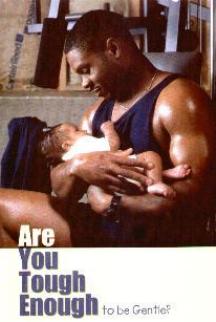Menstuff® has compiled the following information on the Shaken Baby Syndrome. Information on this page is not intended to replace advice by a health care professional. If you are concerned about your child's health please consult a physician.
Shaken baby syndrome (SBS) is the leading cause of death in abusive head trauma cases. An estimated 1,200 to 1,400 children are injured or killed by shaking every year in the United States. Actual numbers may be much higher as many likely go undetected.
Approximately 25 percent of all SBS victims die as a result of
their injuries. Victims who survive may suffer permanent disability
such as severe brain damage, cerebral palsy, mental retardation,
behavioral disorders and impaired motor and cognitive skills. Many
survivors require constant medical or personal attention, which
places tremendous emotional and financial strain on families. Medical
costs associated with initial and long-term care for these children
can range from $300,000 to more than $1,000,000.

Shaken Baby/Shaken Impact
Syndrome
Medical Facts
Physical Consequences of Shaking an
Infant or Toddler
Physical Signs/Symptoms
Conference
Products available:
Shaken Baby/Shaken Impact Syndrome
We studied 173 cases of abusive head trauma in children less than 3 years old who were evaluated at the Childrens Hospital, Denver, Colorado, from 1990 through 1995. Since the mechanism of injury cannot always be accurately determined in child abuse cases, we studied children who had experienced shaking, impact to the head, or both.
The mean age of the 173 children was eight months. All of the children suffered serious head injuries. Thirty-one percent of the children had previously been seen by a physician who did not recognize the diagnosis of abusive head trauma. Many of the 54 children whose head injuries were missed were seen by doctors on multiple occasions after their injuries. For children whose head trauma was missed, the average length of time to diagnosis head trauma from the day of the first doctor visit was 7 days. When missed cases were compared to recognized cases, several factors were found to be significantly different.
Children with missed abusive head trauma were much younger than those in whom the diagnosis was recognized on the first physician visit. The mean age of the missed cases at the time of their first medical visit for head injury symptoms was 180 days. The mean age of the recognized cases was 278 days.
Abusive head trauma was missed significantly more often in children who were Caucasian than in children of minority races, and was more likely missed in families where both parents lived with the child. Not surprisingly, the severely injured children were more likely to be recognized as having head trauma at their first visit to the physician. At the first visit, children who were comatose, whose breathing was compromised, who were seizing or who had facial bruising were more likely to be accurately diagnosed.
We constructed a computer model based on the data to determine how likely a physician would be to recognize the correct diagnosis of abusive head trauma. We found that if a child had normal respirations, no seizures, no facial or scalp injury, and came from an intact family, the probability that abusive head trauma would be recognized was less than one in five.
We do not know how many cases of abusive head trauma are never detected. Parents who confess to shaking or hitting the heads of their children frequently report doing the same thing previously. In one of our study cases, an infant was hospitalized three times after violent shaking before someone witnessed the abuse. Infants have few ways to demonstrate illness or injury. Non-specific signs such as vomiting, fever and irritability are frequently seen in a myriad of conditions, including many minor illnesses. The difficulty, then, is to be able to tell when these signs and symptoms occurred because of serious head injuries.
Are missed cases of missed abusive head trauma inevitable? If a child's caretakers cannot or will not give an accurate history, making the correct diagnosis is extremely difficult. Physicians cannot obtain cranial CT scans on every infant and toddler who is present with vomiting, irritability and fever.
Based on this study and on our experience with these cases, we recommend the following suggestions to physicians to facilitate the diagnosis of abusive head trauma:
Carole Jenny, MD, MBA, is a consultant for the National Service on SBS. She has served on the faculty of the University of Washington and University of Colorado. She is the director of the Child Safe program at Hasbro Childrens Hospital and also serves as a professor of pediatrics at Brown University.
For further information please see:
Jenny, C., Hymel, KP, Ritzen, A., Reinert, SE, Hay, TC. Abusive
Head Trauma:An Analysis of Missed Cases, Journal of the American
Medical Association 281:621-626, 1999.
Source: www.dontshake.com/Subject.aspx?categoryID=12&PageName=MedicalFactsDiagnoseTrauma.htm
![]()
Any of these injuries can lead to severe disability or death. If you suspect a child has been shaken, seek medical attention immediately.
Common Symptoms of Shaken Baby Syndrome:
Source: www.dontshake.com/Subject.aspx?categoryID=12&PageName=SymptomsOfSBS.htm
![]()
Physical Consequences of Shaking an
Infant or Toddler
What Happens:
Immediate Consequences:
Long-Term Consequences:
Why:
When:
Source: www.dontshake.com/Subject.aspx?categoryID=12&PageName=ConsequencesOfShaking.htm
![]()